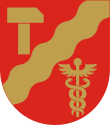
VR-Group Plc, commonly known as VR, is a government-owned railway company in Finland. VR's most important function is the operation of Finland's passenger rail services with 250 long-distance and 800 commuter rail services every day. With 7,500 employees and net sales of €1,251 million in 2017, VR is one of the most significant operators in the Finnish public transport market area.

Soltam Systems is an Israeli defense contractor and kitchen equipment manufacturer located in Yokneam, Israel. The company has been developing and manufacturing advanced artillery systems, mortars, ammunition, peripheral equipment and cooking equipment since 1952. Soltam Systems serves armed and special forces in more than 60 countries as well as the private sector with its kitchen products. Among the company's major customers are the Israel Defense Forces (IDF), the United States Army and NATO countries.

Oy Lokomo Ab was a Finnish manufacturer of railroad equipment and steam locomotives, situated in Tampere, Finland. The company was founded in 1915 by a group of Finnish businesspeople, including Jalmar Castrén and Emil Aaltonen. The Lokomo factories in Tampere produced the MIR submersibles for the Soviet Academy of Sciences. They later merged into the Metso Corporation. Jaakko Syrjä was a worker for the company.

The Soltam K6 is a 120 mm mortar that was developed by Soltam Systems of Israel. It is the long-range version of the Soltam K5 and has replaced older systems, such as the 107-millimetre (4.2 in) M30, in several armies, including the United States Army. It is much lighter than the M30, has a greater range, and can sustain a rate of fire of four rounds per minute, while the M30 could sustain only three.

Tampere Central Station is a functionalist building in Tampere, Finland, designed by Eero Seppälä and Otto Flodin, completed in 1936. The station is one of the most important railway stations in Finland. In 2015, the Tampere Central Station was the second busiest railway station in Finland in terms of numbers of passengers, after the Helsinki Central Station.

The 155 GH 52 APU, Finnish designation 155 K 98, is a Finnish towed artillery piece developed in 1998. It is largely based on the 155 K 83 with some major enhancements. It can be moved on the field short distances with its own auxiliary diesel engine, which is used in all 56 units used by the Finnish defence forces, is a 78-kilowatt Deutz diesel engine. The Egyptian units are not equipped with the APU.

Škoda Transtech Oy is Finland's major domestic manufacturer of low-floor tram and railway rolling stock. It specializes in building tram and railway vehicles for extreme climatic conditions, such as those encountered in Finland.
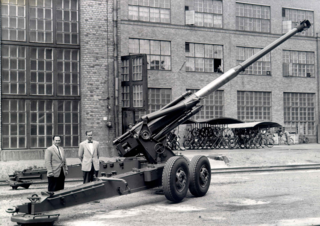
The 130 K 90-60 is a Finnish towed 130 mm coastal artillery piece, manufactured in the 1980s by Vammas.
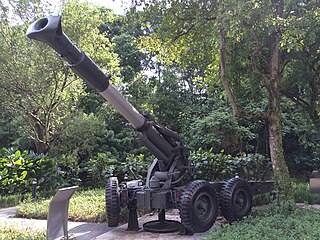
The M-68 was a 155 mm L33 caliber towed gun howitzer manufactured by Soltam Systems of Israel, and used by the Israeli Defense Force.

81 KRH 71 Y is a light mortar manufactured by Tampella for use by the Finnish Army. It is usually used to support the infantry by indirect fire, but it can also be used for direct fire. Each Finnish infantry company has a platoon of 81 mm mortars. The mortar platoon consists of three seven-man mortar squads, each squad manning a single 81 mm mortar. Jaeger Company M2005 has a fire support squad, which consists of two five-man mortar teams, both equipped with an 81 mm mortar. It can fire HE-fragmentation, smoke, illumination and practice rounds.

The Jokioinen Railway located in Jokioinen, Finland, was opened for temporary traffic on December 9, 1898. On October 25 1899, the railway began permanent passenger and freight services.
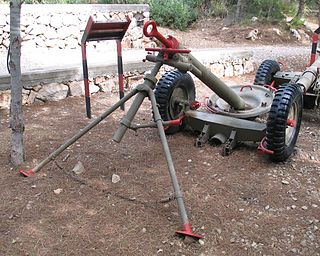
The Soltam M-65 is a 120 mm mortar that was developed by Tampella in 1953 via introduction of new baseplate for 120 Krh/40 invented by Hans Otto Donner. In 1960s Soltam Systems of Israel bought a license. The mortar system comes in two versions, a standard mortar and a long-range version.

The 120 KRH 92 is a 120 mm mortar manufactured in Finland.

120 Krh/40 is a 120 mm mortar developed by the Finnish company Tampella.
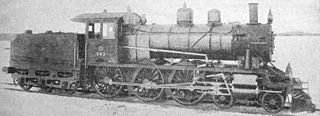
The Finnish VR Class Hv1 was a 4-6-0 express passenger train locomotive. 42 were built between 1915 and 1921. They were numbered 545–578 and 648–655.

The VR Class Vr3 was a class of steam locomotive built in Finland. Before 1942, the class was known as O1. They were nicknamed Kukko and they have the same frames and boiler as the Vr Class Pr1 (Paikku) locomotive. The first locomotive was ordered in 1924 from Hanomag of Germany, number 10 351 and it was numbered 752. The remaining 4 were produced by Tampella Oy in Tampere. They were numbered 752 to 756.

The VR Class Tr1 is a class of heavy freight locomotive built in Finland and Germany. Before 1942 VR Class Tr1s originally had the class name R1. They were nicknamed “Risto”, after the Finnish President Risto Ryti. They were numbered 1030–1096.

VR Class Dr12 was a heavy diesel-electric locomotive of Valtionrautatiet. The first six locomotives were ordered in 1956. They entered service between 1959 and 1963. The locomotives were built by two manufacturers, Valmet and Lokomo, both based in Tampere. All Hr12 class locomotives with even numbers were produced by Valmet, while all odd numbers were produced by Lokomo. The locomotives were withdrawn in the early 1990s.
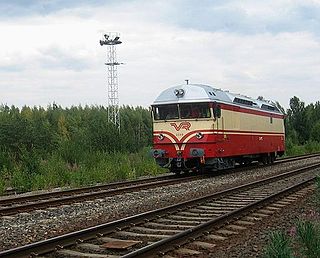
VR Class Dr13 was a heavy diesel locomotive used by VR Group. The Dr13 was designed by the French company Alstom. The class consisted of 54 locomotives, of which the first two were built by Alstom’s factory in Belfort, France and were shipped to Finland in 1962, while the rest were built in Tampere at the factories of Lokomo and Valmet. The first Dr13 series locomotive came to Finland on 24 October 1962. The Dr13 series was introduced between 1962 and 1963, and the last units were withdrawn by June 2000.
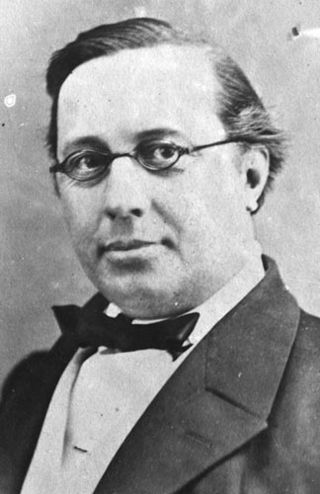
Adolf Törngren was a Finnish jurist and industrialist.

























